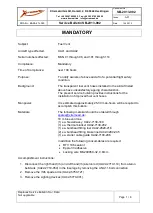
14
Negative spin
A negative spin does not conform to the ROLLER’s normal flight behaviour.
Certain circumstances however, may provoke a negative spin (such as
trying to turn when flying at very low air speed whilst applying a lot of
brake). It is not easy to give any specific recommendation about this
situation other than quickly restoring the wing’s default air speed and angle
of attack by progressively reducing the tension on the brake lines. The
normal wing reaction will be to have a lateral surge on the re-accelerated
side with a rotation not greater than 360º before returning to default air
speed and a straight flight path trajectory.
Parachutal stall
The possibility of entering or remaining in a parachutal stall has been
eliminated from the ROLLER.
A parachutal stall is virtually impossible with this wing. If it did enter into
a parachutal stall, the wing loses forward motion, becomes unstable and
there is a lack of pressure on the brake lines, although the canopy appears
to be fully inflated. To regain normal air speed, release brake line tension
symmetrically and manually push on the A-lines or weight-shift your body
to any side WITHOUT PULLING ON THE BRAKE LINES.
Deep Stall
The possibility of the ROLLER stalling during normal flight is very unlikely.
It could only happen if you are flying at a very low air speed, whilst over-
steering or performing dangerous manoeuvres in turbulent air.
To provoke a deep stall, the wing has to be slowed down to its minimum
air speed by symmetrically pulling the brake lines all the way (100%) down
until the stall point is reached and held there. The glider will first pitch
rearward and then reposition itself overhead, rocking slightly, depending on
how the manoeuvre was done. When entering a stall, remain clear-headed
and ease off the brake lines until reaching the half-way point of the total
the brake travel. The wing will then surge violently forward and could reach
a point below the pilot. It is most important to maintain brake pressure until
the glider has returned to its default overhead flying position.
To resume normal flight conditions, progressively and symmetrically
release the brake line tension to regain air speed. When the wing reaches
the overhead position, the brakes must be fully released. The wing will
then surge forward to regain full air speed. Do not brake excessively at
this moment as the wing needs to accelerate to pull away from the stall
configuration. If you have to control a possible frontal collapse, briefly pull
both brake handles down to bring the wing back up and release them
immediately while the glider is still in transition to reposition itself overhead.
Cravat
A cravat may happen after an asymmetric collapse, when the end
of the wing is trapped between the lines. Depending on the nature
of the tangle, this situation could rapidly cause the wing to spin. The
corrective manoeuvres to use are the same as those applied in case of
an asymmetric collapse: control the turn/spin by applying tension on the
opposite brake and weight-shift opposite to the turn. Then locate the
stabilo line (attached to the wing tip) trapped between the other lines. This
line has a different colour and is located on the outside position of the
B-riser. Pull on this line until it is taught, as it should help undo the cravat.
If ineffective, fly down to the nearest possible landing spot, controlling the
direction with both weight-shift and the use of the brake opposite to the
tangled side. Be cautious when attempting to undo a tangle while flying
near terrain or other paragliders; it may not be possible to continue on the
intended flight path.
Over-controlling
Most flying problems are caused by wrong pilot input, which then
escalates into a cascade of unwanted and unpredicted incidents. We
should note that the wrong inputs can lead to loss of control of the glider.
The ROLLER was designed to recover by itself in most cases. Do not try to
over-correct it!
Generally speaking, the reactions of the wing, which are caused by too
much input, are due to the length of time the pilot continues to over–
control the wing. You have to allow the glider to re-establish normal flying
Summary of Contents for ROLLER
Page 1: ...USER S MANUAL ROLLER...
Page 21: ...21 10 3 RISERS LAYOUT...


































